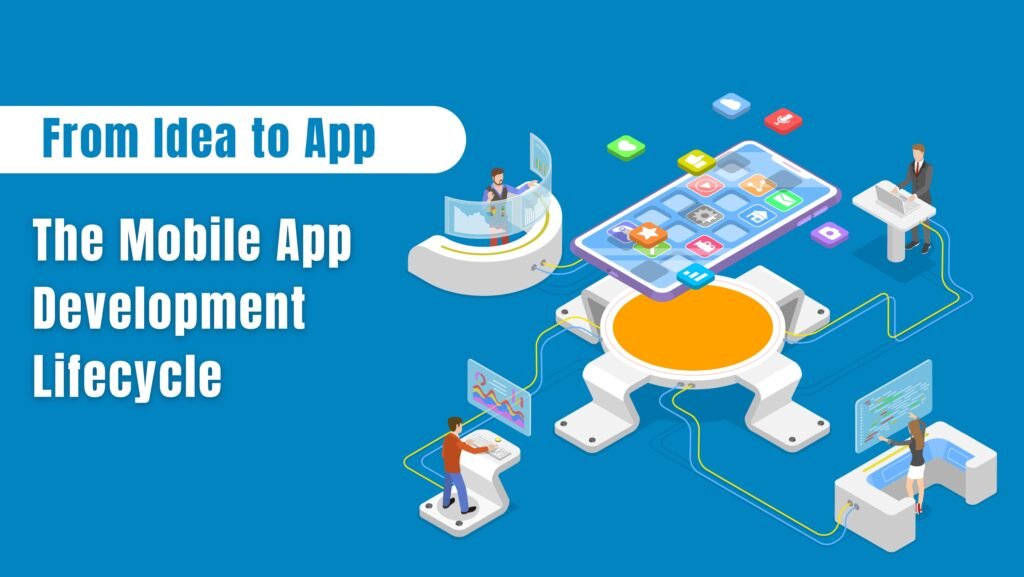Introduction
Mobile app development is the process of creating software applications specifically designed to run on mobile devices, such as smartphones and tablets. It involves designing, coding, testing, and deploying apps for platforms like iOS and Android, tailored to diverse user needs and functionalities. Mobile app developers use various programming languages and development tools to deliver a seamless and engaging user experience.
Over the past few years, creating mobile applications has become increasingly popular. This specific area of software development is all about making apps that work really well on various mobile devices. This growth reflects how much we use our smartphones and tablets in our everyday activities.
More than 80% of the global population owns a phone but what are people primarily doing with these devices? The answer is simple, they are using apps
There is a whole process needed for mobile app development, from the initial idea to bringing it to real life, and this article will guide you through the entire journey.
How mobile app development is shaping the digital landscape?
Mobile app development is crucial in today’s world due to the widespread use of smartphones. It empowers businesses to reach and engage with a global audience, enhance customer experiences, and drive revenue through mobile platforms. Apps offer convenience, personalization, and accessibility, making them essential tools for both companies and individuals in the digital age.
Additionally, the relationship between mobile apps and data security has become increasingly significant, with developers and users alike prioritizing the protection of personal information in an interconnected world. In this context, app developers and businesses must continually invest in refining their mobile strategies to maintain relevance and build lasting relationships with their customer base.
According to Zippia, there are over 459,382 web developers currently employed in the United States. This shows that web development is a really popular job in the country. The number of web developers worldwide is also going up fast.
Mobile App Development: A Step by Step Breakdown
Creating and launching a mobile app involves several steps, kind of like a recipe. Like any other project, making a mobile app involves a series of steps. First, you figure out what your customer needs. Then, you create a plan, like a roadmap, before actually building the app. Developing an app becomes easy when you break it into steps. If you want to make apps, follow these simple guidelines:
- Ideation and Conceptualization
- Planning and Strategy
- Design and User Experience
- Development
- Testing & Release
- Monetization and Revenue Generation
Ideation and Conceptualization:
Ideation and Conceptualization is the initial stage in the mobile app development lifecycle, where the main focus is on brainstorming, generating, and refining the ideas that will eventually shape the app. This phase involve some of the keypoints:
- APP Idea: At the core of this stage is the generation of a unique and viable app idea. This idea is often based on identifying a problem or need that can be addressed through an app. The idea should be innovative and have the potential to attract a target audience.
- Market Research and Target Audience Analysis: To validate the app idea, developers and stakeholders need to conduct thorough market research. This involves studying the competition, understanding user demographics and behaviors, and assessing the demand for a solution like the proposed app
- Project and Budget: After completing the market research, make a plan that lists the steps, things you need, and how long it’ll take. Also, estimate how much money you’ll need for the project, which helps in getting funding or resources.
Planning and Strategy:
The second stage is planning and strategy. It is like mapping out your app’s journey. In this phase, it’s important to set clear goals, figure out who will use your app, do some research about what people want, and make sure your app is easy to use.
- During this phase, you’ll also find the challenges and risks that may arise throughout the development process.
- Decide how your app will make money, follow the rules, and come up with a plan to tell people about your app.
By this phase, you have a clear idea of what type of mobile app you need to build, who will be building the app and which platform you’ll use. During this step, you’ll make a plan for your product. You’ll decide what features to build first, when to build them, and set goals to help you reach your release date on time.
Design and User Experience:
The mobile app’s design phase is where its look, features, and function start to form.
During this part of app development, you’ll plan how users will interact with it and make different versions of what it will look like.
- You might begin with simple sketches to test ideas or get feedback from customers early on.
- Create the app’s layout, colors, and buttons, while considering how users will interact with it.
- Decide how users will move between different parts of the app, like through menus or buttons
- Create interactive features, like swiping, tapping, or gestures, to make the app engaging
It’s important to keep everyone informed about the technical requirements for the devices the app will run on. This way, when you eventually create the final app design, it’ll be something that can actually be made.
Development:
Development is the phase where the app’s design comes to life. It is the software development phase of mobile app development.
Skilled programmers and developers write the actual code that makes the app work. They use programming languages and tools to build the features, functions, and logic defined in the design. In the development phase of app development, you’ll need:
- Development Tools: Software and tools for coding, debugging, and testing.
- Codebase: The actual code that defines the app’s functionality.
- Database: Storage for app data, like user accounts or content.
- APIs (Application Programming Interfaces): To connect with external services or data sources.
- Testing Environments: Test devices or emulators to check how the app performs.
- Documentation: Detailed instructions and notes for future maintenance and updates.
During development, the app’s backbone is constructed, and it starts to perform the tasks you expect, like displaying information, processing user inputs, and connecting to the internet.
Testing & Release:
Testing and release are crucial steps in the mobile app development process to ensure that the app functions correctly and is ready for distribution to end-users. These steps involve a series of activities and processes to identify and fix bugs, improve performance and prepare for the launch.
- Developers start with unit testing to ensure individual components function correctly, followed by integration testing to verify interactions between components.
- Functional testing checks that the app’s features work as intended, while performance testing assesses speed and resource usage. Compatibility testing ensures the app works on various devices and screen sizes.
- Security testing identifies vulnerabilities, and usability testing gathers feedback from real users.
After passing these tests, the app is submitted to app stores, undergoes store reviews, and is released to the public. Post-launch monitoring helps maintain and improve the app’s quality and competitiveness.
Monetization and Revenue Generation:
Monetization and revenue generation in the context of mobile app development refer to the strategies and methods employed to make money from the app. Mobile app developers often invest time, resources, and creativity in building their apps, and monetization is essential to sustain the development and potentially generate profit.
It can be achieved through various approaches, including paid apps, in-app purchases, premium models, subscriptions, advertising, sponsorships, affiliate marketing, data monetization, crowdfunding, cross-promotion, and pay-per-download.
Conclusion:
To conclude, mobile app development is a complex process that combines technical expertise, user-centric design, and effective monetization strategies. Staying adaptable and responsive to user feedback and industry trends is key to creating successful apps in a competitive market.







